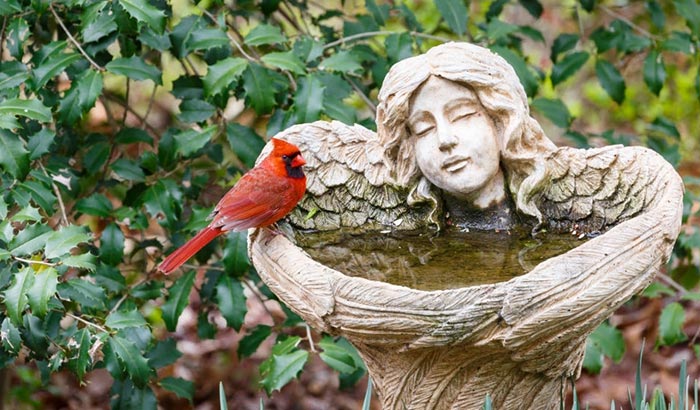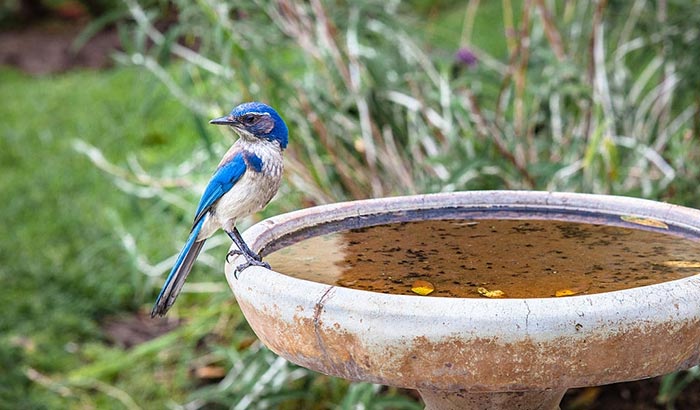Birds need baths to keep themselves clean as well as quench their thirst after moving places. That’s what bird baths are for; they aren’t there to simply ramp up your backyard, but also provide a dependable water supply for the birds.
Since the bird feeders have been quite an attraction, I thought it would be just as easy to have birds come by. But as the days passed, I realized it was pretty challenging to get birds to use a bath.
Fortunately, with some research and practical application, I’ve learned effective ways to attract birds to a birdbath. Thus far, I’ve figured out three crucial factors: (1) The location of the birdbath makes a huge difference, (2) The water depth is a fundamental element to consider, and (3) Proper maintenance is a must.
As you read on, you’ll find these aspects as well as the comprehensive steps that you can try and hence, draw more birds to a birdbath in your backyard.
Contents
12 Easy Ways on How to Get Birds to Use a Bath
1. Find the perfect location
There are two main factors to consider when choosing a location for your birdbath: accessibility and safety.
First of all, you get to attract the birds and let them dwell in your backyard anytime. Therefore, the ideal place would be where you and the birds can easily access the bath with uttermost safety.
Position the bath where you can see it, not only for pleasure but also to look after them in case predators are lurking around or any possible hazards.
Secondly, setting it up on a suitable spot promotes hassle-free cleaning. You’ll be able to visit your birdbath and conduct some cleaning and maintenance whenever you need to.
Aside from that, taking the location into account is highly imperative, especially if you’re planning to install an electric water pump for your birdbath, perhaps for the water movements and fountains.
While these features spruce up the attraction, they might also lead to accidents. That’s why you must plug it into an electric outlet that has a ground fault circuit interrupter to prevent electrocution and fire.
2. Set up the birdbath on the ground
Although elevated birdbaths or pedestal designs can be quite a stunner in your garden or backyard, they may not be as appealing as the birdbaths placed at ground level.
Since birds usually drink on shallow parts of streams or ponds, baths on the ground lend a familiar environment where they would typically find water.
3. Make sure to keep the water depth shallow
Birds enjoy bathing in shallow waters. Therefore, it is important to aim for a reasonable water depth whether it is in a plastic bowl or a bath pedestal. The edges should only be 0.5 to 1-inch deep, and if it slopes down the center, the water should be at a maximum of 2 inches.
4. Try putting rocks at the bottom
If the structure of the bowl or basin seems too deep or the material is too slippery for the birds, one quick and effective solution is to place rocks at the bottom of the bath. This provides better footing so the birds will have a sturdy platform to stand on when they’re bathing.
5. Revamp the bath with moving water
Birds are often fascinated by any motion in their bath like fountains or dripping water. This is because any movements in the water shimmer in the sunlight thus captivates the birds’ attention.
For this reason, you may consider adding fountains, perhaps a dripper or mister connected to your hose that’s turned on a low setting. If any of these aren’t available, you can always make your own with recycled plastic containers or buckets.
Some also invest in an electric water pump to stimulate water movements in the basin. However, this requires extra precaution to prevent any accidents such as fire and electrocution. That’s why it is imperative to use an outlet equipped with a fault circuit interrupter.
On the other hand, if you think electrical water pumps would be unsafe and cumbersome, you may consider a solar water fountain pump since it functions without using electricity or batteries.
6. Add a staging or preening perch
Setting up a perching platform paves way for a more comfortable landing, especially if you want birds of a variety of species and sizes to come over. While this also makes the bath more inviting, it also serves as a preening station for birds after bathing. Furthermore, some birds use it to detect if there’s any danger nearby.
You can embellish your birdbath with a stick or platform next to it. You don’t want to place it over the bath; otherwise, they’ll probably find it as a spot for pooping!
7. Place it under a protective shade
To keep the water cool and prevent it from evaporating too quickly, it is best to place the birdbath under a shade. Birds take delight in baths to cool themselves down and a bath of heated water won’t be the perfect place for it.
With this in mind, you should find a spot where you can take a bath from direct sunlight like under a tree or patio shades, especially in the intense heat of summer.
8. Set up birdhouses
When the harsh temperatures in winter take over the season, birds are unlikely to come around unless you have birdhouses or nest boxes nearby. This serves as a shelter during winter as well as a comfortable environment for your little friends.
9. Provide a heated bath in winter
Birds need an available water supply all year-round; however, getting the birds to use a bath in winter might seem difficult due to ice freezing temperatures, not to mention the birdbath that would’ve probably turned ice cold.
Fortunately, you can still attract birds to a bath before the water freezes or turns into ice. The easiest way is to place a basin with heated water and replace it each time you notice any formation of ice.
On the other hand, if you don’t mind spending a few bucks on heaters, you can find one in hardware stores, bird feeder stores, or any electrical supply shops. Some birdbaths have built-in heaters but you can also purchase the heater separately. Just make sure to install it properly and plug it in a fault circuit interrupter to deter electric shock.
10. Keep it away from potential predators
Birds will likely return to your backyard for an enjoyable bath once they find out that it’s a safe place to do so. Since it is ideal to set up a birdbath on the ground, you should make sure to conceal it from your sneaky cats or other predators that might scare the birds away.
11. Make sure to change the water from time to time
One of the ways on how to keep bird baths clean is to change the water now and then, preferably after one to two days. Since birds use it for cleaning themselves, you might sometimes find droppings or dirty feathers that would be unhealthy for the birds.
12. Always keep your bird baths clean at all times
Proper and regular maintenance is a must to ensure a healthy and clean environment for the birds. If left unclean for a long time, it will foster algae and bacterial growth, which can potentially contaminate the water with infection and other viruses. It can also become a place for mosquitoes to lay eggs.
https://www.youtube.com/watch?v=KGL1lvFHiVk
Conclusion
In a nutshell, making bird baths more inviting isn’t just all about fancy embellishments; it involves several significant factors as mentioned above. If you set it up in a safe and proper location, supply clean shallow waters, and provide regular maintenance, birds will definitely enjoy bathing, drinking, and dwelling in a safe environment all at once.


